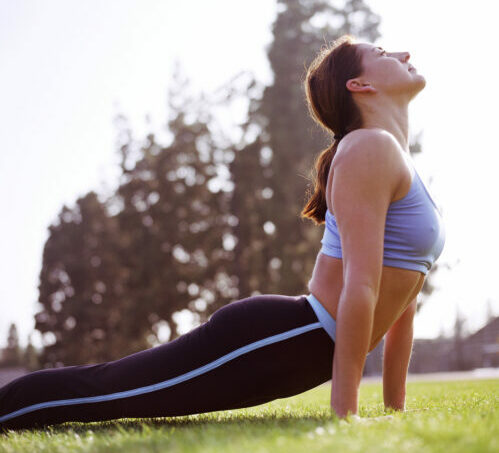Agility as understood in the sense of physical mobility is the ability to perform body movements with a certain range of motion. The possible range of mobility is determined on the one hand by the elasticity of the muscles or joints, but also by the control over them.
Agility is therefore a combination of flexibility and mobility.
The aim of flexibility training is to increase mobility in terms of range of motion, while control and the quality of movement play a major role in mobility training.
Why mobility is so important for us
The older we get, the less mobile we seem to be. On the one hand, this is influenced by the ageing process of our tissue, as the cells can no longer renew themselves optimally. However, it is mainly due to the growing lack of exercise and our increasingly inactive lifestyle. As small children, we explore our surroundings, run, climb or jump around. Many children are in a sports club and take regular exercise several times a week. As we get older, the time we spend exercising decreases. For this simple reason that we move much less, our mobility becomes increasingly limited. But is this bad, or what does it have to do with our health?

The musculoskeletal system has several basic abilities that it needs to be efficient and to be able to master all the tasks of everyday life. Besides stability and good movement patterns, mobility is one of these abilities. Almost every adult has had certain tension or pain, so-called musculoskeletal problems, at some point in their lives. In other words everything that has to do with our muscles and the skeleton. In addition, there are sometimes dysfunctions and movement deficits. All these problems are often due to the fact that the musculoskeletal system has lost some of its basic abilities.
Our body consists of many different components. Besides the ligaments, tendons and fasciae, joints and muscles are mainly responsible for good stability and mobility. In some parts of the body, such as the lower back, we should avoid too much movement. This area should be stable. Other parts, especially the shoulders or hips, should remain as mobile as possible. It is therefore difficult to make general statements and say: the more mobile you are, the better. There are areas of the body that should deliberately not be too mobile.
If your shoulder joint is not flexible enough, this can very quickly lead to tension in the shoulder-neck area. Particularly one-sided strains in this area quickly lead to an overexerted muscle and thus to problems. The situation is similar with the hip joint: if your pelvis cannot move freely, the body has to compensate for the lack of mobility and thus puts additional strain on other components, even though they were not designed for this purpose. In this case the lumbar spine and the lower part of the back extensor are at risk. Dr. Eric Cobb, a world-leading expert in the area, says:
"A disrupted joint will lead to a disrupted muscle."
To find out how your shoulder and hip mobility is and how flexible it should be, you can do a self test HERE.
How can I improve my mobility?
You do not need to spend hours stretching or doing mobility programmes to achieve sufficient mobility for your body. It is more important to take regular and varied exercise in everyday life.
Are you often physically active and on your feet in your job? Then pay attention to counter-movements and balancing exercises so that your joints and muscles are not strained on one side only. Stretch your arms over your head or stretch your hips slightly. Do you work in an office or have a job that is mainly of a seated nature? Then take an active break every 1-2 hours and integrate exercises for mobility into your everyday life.

Here are two techniques that are particularly effective: static stretching and dynamic mobilisation. During static stretching, you bring the target muscle to length in a controlled manner and hold this position for about 20-60 seconds. Dynamic mobilisation means to move the joint in its currently largest range of motion. Example exercises are shoulder circling, head rotation or foot circling.
You can find more exercise ideas on our TRAINING CARDS. Print it out and place it as a reminder at your workplace or at home.
Stretching during sports?
To stretch or not to stretch? This question has occupied sports science for decades. But mostly in a specific context, namely the benefits for athletic performance.
"Should I stretch before or after training?"
Intensive static stretching should not be performed either before or directly after the training. Using this method to work on your flexibility works better in a cold state without being followed by dynamic movement. Many studies now show that static stretching during warm-up reduces performance and increases the risk of injuries. In order to prepare the body for the upcoming strain, it is recommended to integrate dynamic mobilisation or dynamic stretching into the warm-up.
References
- Patrick Meinart: Zurück zur Beweglichkeit (2020)
- Aguilar et al 2012, J Strength Cond Res: A dynamic warm-up model increases quadriceps strength and hamstring flexibility
- Van Gelder & Bartz 2011, Journal of Strength and Conditioning Research: The effect of acute stretching on agility performance
- Haddad et al 2014, J Strength Cond Res: Static Stretching can impair explosive performance for at least 24 hours



